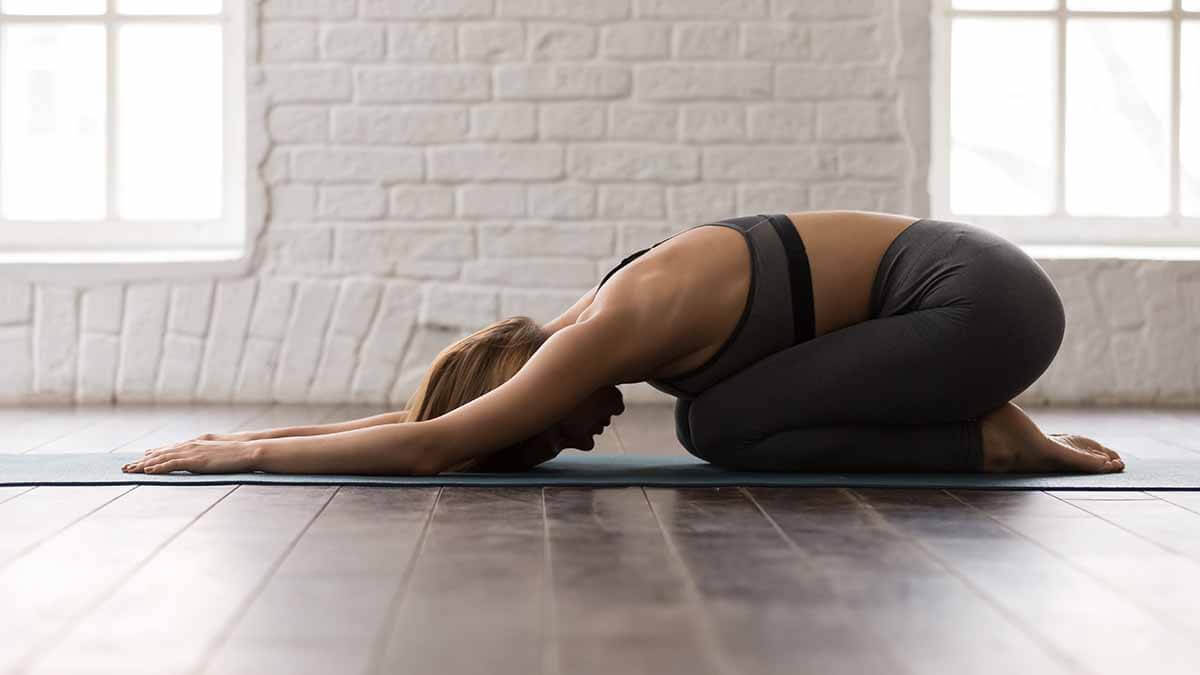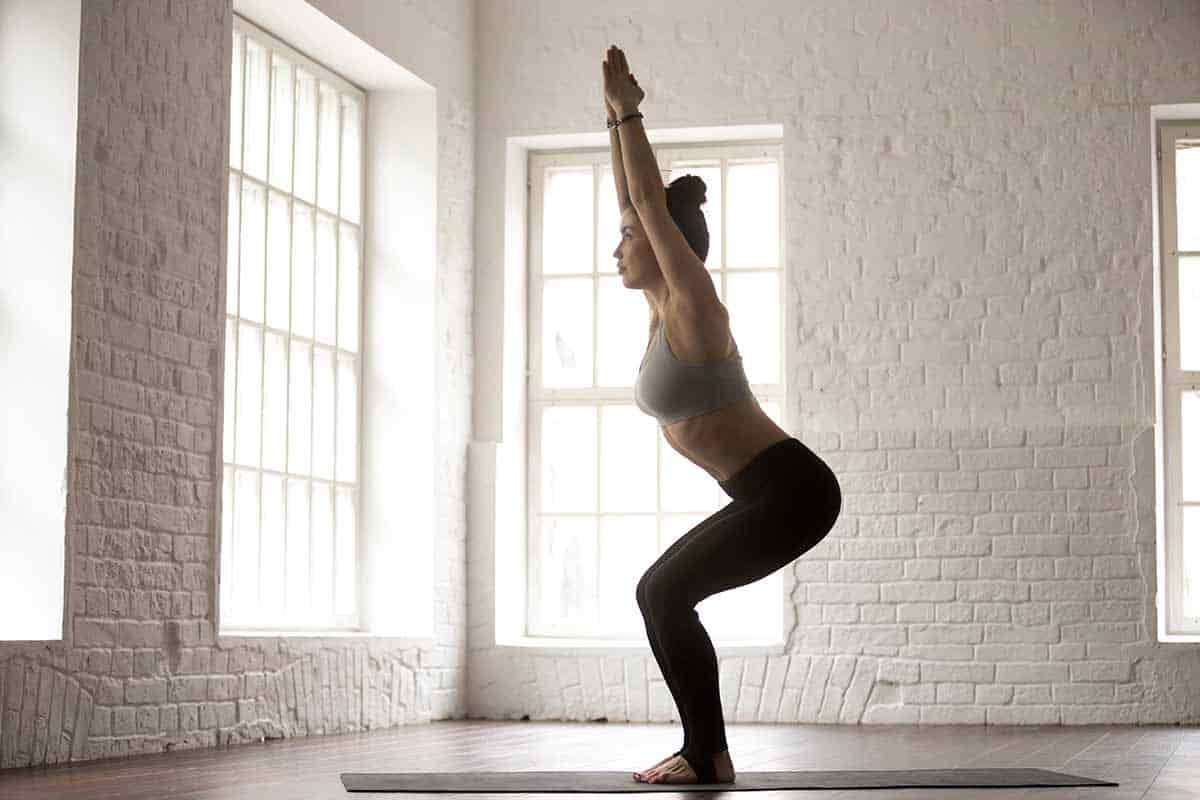
oing yoga at home isn't always easy, as it can be difficult to watch the TV as you get into complicated poses which involve putting your head down. But many of these poses are easier than you think and can be great for your health. One example is a pose known as child's pose.
Child’s pose is a simple yoga pose known for its gentle stretching and beneficial qualities. Like any yoga pose, however, if child’s pose is performed incorrectly, it can cause you to injure yourself, so be sure you are performing it correctly when you practice yoga at home.
Ready to ensure you are getting all the benefits of child’s pose and executing the stretch correctly? Keep reading to learn more about child’s pose and how it can benefit your life.
Article Topics
What is a Child's Pose in Yoga?
Child’s pose is a popular yoga pose that is typically taught to people right when they are beginning their journey with yoga. This is because it is simple to get into and typically can be formatted to lead to other, more complicated poses.
Not only is child’s pose a great stretch for several different parts of your body, but it is also a great pose to relax in because it isn’t too strenuous. Child’s pose may look like someone on their knees simply leaning forward, but the pose is much more complicated than that.
After performing a child’s pose, many yoga instructors will ask you to come onto your knees for tabletop position. It also easily lends itself to a downward dog transition. During your yoga journey, you may find yourself struggling to perform a certain pose, at which time your instructor will tell you to return to child’s pose like a physical reset.
For this reason, child’s pose is the most commonly known yoga pose out there and also one of the most performed. So if you want to get familiar with yoga, you’ll need to increase your knowledge of child’s pose because you’ll be performing it a lot!

What is the Sanskrit for Child's Pose?
During yoga class, many of the poses are referred to by their original Sanskrit name. Child’s pose is the English name for this position, and the Sanskrit name is balasana, which roughly translates to child’s position, which is where the English name is derived.
If you struggle with the Sanskrit names of the poses, don’t fret, as most teachers will use both the Sanskrit and English names when referring to poses. If this doesn’t calm your nerves, just be sure to chat with the teacher before the class and make them aware that you aren’t familiar with the Sanskrit name.
Even in practices where almost all Sanskrit names are used, Child’s pose is one that is almost always referred to by its English name.
What is Child's Pose Good For?
Child’s pose, while it may seem very simple and easy to perform, is actually a critical part of almost every yoga practice. This is because pairing the Child’s pose exercise with breathing can help relax the mind and prepare the individual for their yoga practice.
Additionally, the Child’s pose position is a good stretch for several parts of your body, helping prepare your muscles and joints for the harder parts of your practice. Typically, a yoga instructor will tell you to return to Child’s pose during practice if you come across a pose you cannot perform.
Sometimes, after spending some time in Child’s pose, you will feel refreshed and able to conquer a difficult yoga pose when you try again. For this reason, Child’s pose is critical to many yoga instructors.
Not only is it critical for finding your center after struggling with a pose, but Child’s pose is also a great transitionary pose. Instructors will typically have the class start in Child’s pose, then return to it multiple times during the class. Usually, after Child’s pose, you will change to a tabletop position or downward-facing dog.
What are the Steps to get into Child's Pose?
Even though it might be an easy beginner’s pose, it’s important to know the steps to get into a proper Child’s pose. If performed incorrectly, it is still possible for you to injure yourself, even with an easy pose like Child’s pose.
- Step 1: Sit on Your Knees on the Floor: Be sure your toes are together and that your knees are about your hip-width apart. Relax your hand on your thighs.
- Step 2: Lean Forward: As you exhale, lean forward, letting your stomach come to rest on your thighs. Move your arms to rest alongside your body.
- Step 3: Reach Forward: Once your upper body is resting on your thighs, bring your arms up over your head and reach for the floor in front of you. Move your hands as far forward as possible until you feel a stretch. Spread your fingers and ensure your palms are flat on the floor.
- Step 4: Relax: Take many deep breaths in this position, rest your forehead on the floor, and relax—you earned it! You can close your eyes if you would like to as well.
If you are worried about getting in and out of child’s pose without causing injury to yourself, don’t be afraid to ask the instructor for help. If you are practicing yoga at home, there is usually a question box where you can ask questions, so don’t be afraid to use it!
You can also sign up for a yoga course online that includes evaluation, as these teachers will be able to look at your pose and let you know what you need to correct in order to do it properly. Remember, you may not be a pro at first, but if you keep trying, you’ll be there soon enough!
What is the Variation of the Child's Pose in Yoga?
As with many yoga poses, there are several variations of Child’s pose to adjust the pose to work for you.
The first variation is to leave your arms along your side instead of reaching forward. Some people find this adjustment to be more relaxing for them. It makes the pose less active and even more of a resting pose.
Are you having trouble getting your bottom to rest on your heels? This is a common issue due to low knee flexibility. It will get better with time, but in the meantime, place a rolled-up cloth between your thighs and your calves to help you relax in the stretch.
If you are pregnant, there is no reason to skip child’s pose, as you can perform it the same way, but you’ll need to put something under your belly, such as a bolster, to give you support.
3 Benefits of Child's Pose in Yoga
Besides just being a good reset position, there are many health benefits to performing child’s pose. This is why so many instructors incorporate the exercise into their routines.
Child's Pose is a Full Body Stretch
In the practice of yoga, most stretches focus only on a certain muscle group, but child’s pose is a stretch that can release tension in your entire body.
By sitting on your knees to begin, the muscles, tendons, and ligaments of the knee are stretched. This is especially helpful for those who may suffer from knee pain or tension due to running or other vigorous exercise.
But it isn’t just the knees that benefit because as you lean forward, your back, shoulder, and chest all get a great stretch, as well as your hips, thighs, ankles. This is quite a few parts of your body that are getting stretched all at once, which releases any tension you may be holding in your muscles.
Because child’s pose is such a good stretch, this is why it is typically done at the beginning of a yoga practice as a warm-up, because it helps prepare your body for what is to come.
Child's Pose is Relaxing
The best and second biggest benefit of child’s pose is that it’s relaxing—which can’t be said about all yoga poses. Child’s pose doesn’t just feel relaxing, as it contains many aspects that naturally help your body to relax.
When you rest your forehead on the floor, this produces a calming and soothing effect in the brain, helping to slow racing thoughts. And when your thoughts are no longer racing, this can help you to properly clear your mind and prepare for your yoga practice.
Additionally, with your lungs in this slightly slanted down position and your arms over your head, you’ll find that it’s easier to breathe. Breathing easier helps your body to better regulate circulation in addition to your breath. This means you’ll be breathing easier in Child’s pose, which is much more relaxing than struggling for breath.
Child's Pose Relieves Pain
Many people think of yoga as something which relieves pain, and much of this is thanks to child’s pose. Child’s pose is a pain-relieving position for several reasons.
As you lay on your thighs and stretch your arms over your head, this stretched the spine, something most sedentary people don’t do every day. This is crucial when it comes to alleviating low back and neck pain.
In this day and age, many people suffer from digestion issues, and Child’s pose helps address this pain as well. As the stomach rests on the things, this flexes and massages many of your internal organs, including the stomach. This aids your digestion and relieves many of the painful symptoms associated with poor digestion, such as gas and heartburn.
And because it’s a full-body stretch, if you have muscle pain in other parts of your body, it is likely that child’s pose can help with these as well!
Final Thoughts on Child's Pose in Yoga
There is no doubt about it, Child’s pose is one of the most beneficial poses in yoga, which explains why it is normally part of every yoga practice! Although it is considered to be a beginner pose, there are many variations of Child’s pose that can be used if you can’t perform the pose to its full extent.
Once you get the hang of Child’s pose, you will love how great you feel after doing it. There are simply so many benefits to this amazing yoga pose that there is no reason not to perform it at least once a day—even if you don’t have a yoga practice that day! No matter how busy your schedule is, try to slip in at least one child’s pose a day. You won’t regret it.



